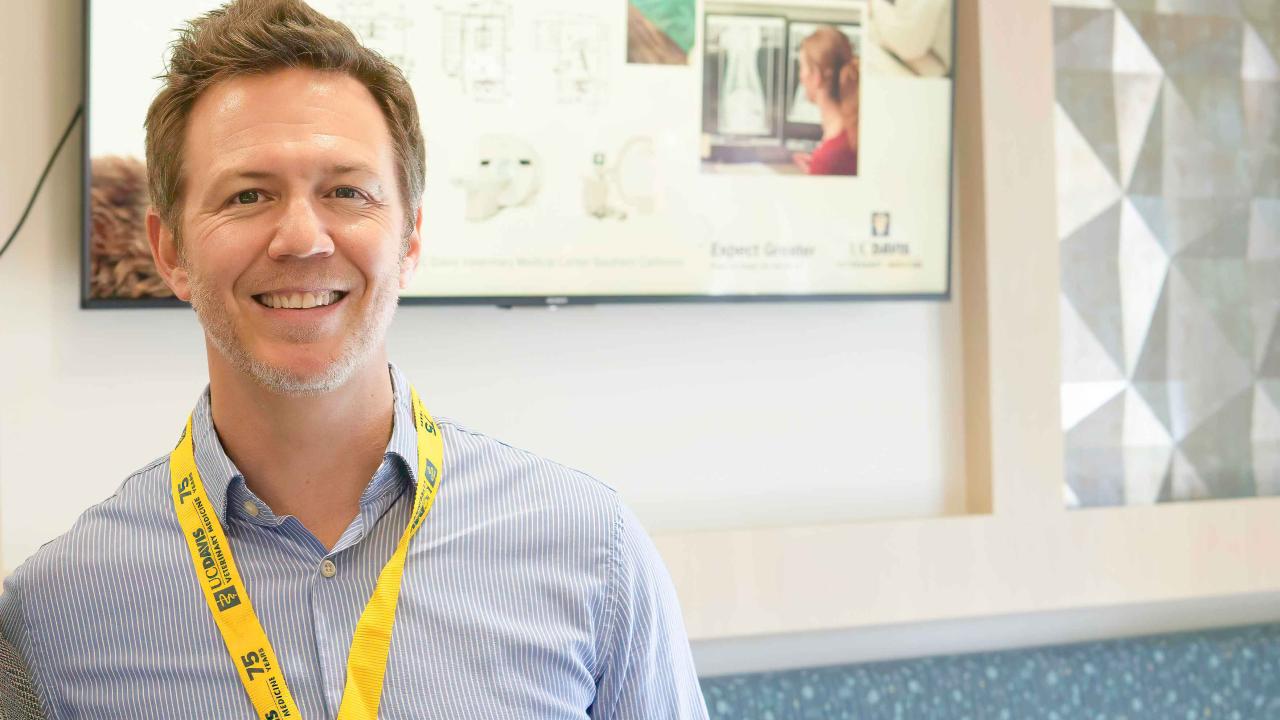
A Typical Day for a Veterinary Cardiologist: Dr. Timothy Hodge
Meet Dr. Timothy Hodge, one of the Southern California clinic's faculty members and veterinary cardiologist.
Quick Summary
- A typical day for a veterinary cardiologist is usually not “typical” due to the variety of cases, says Dr. Timothy Hodge, DVM, DACVM, veterinary cardiologist at the UC Veterinary Medical Center, Southern California.
A typical day for a veterinary cardiologist is usually not “typical” due to the variety of cases, says Dr. Timothy Hodge, DVM, DACVM, veterinary cardiologist at the UC Veterinary Medical Center, Southern California. This specialty is essential for diagnosing and managing different types of heart-related issues in companion animals, and sometimes in larger animals such as horses, and those at the San Diego Zoo.
If heart issues are suspected, veterinarians will refer to the clinic, where Dr. Hodge and the team consult to see what the underlying cause could be. Courses of action to resolve the issues are discussed, as well. Heart diseases in dogs that are most common are cardiomyopathy for larger dogs, and valve issues for smaller dogs. Cats also experience a variety of issues, depending on age and breed. Often, when certain congenital anomalies are diagnosed in younger dogs and cats, the resolution can mean a long, healthy life.
Dr. Hodge sees patients throughout the day. Appointments can take about an hour. Each patient receives an echocardiogram (ultrasound of the heart) before seeing Dr. Hodge. Where possible, Dr. Hodge and team at the clinic also repair certain heart anomalies through surgical intervention. Twice a month, days are blocked for non-emergency interventional or surgical procedures.
An Interest Since High School
Dr. Hodge became interested in veterinary medicine in high school when he assisted a veterinarian in a clinic and on the veterinarian’s farm. After his undergraduate work, he earned his DVM from Purdue University. It was around his fourth year at Purdue when he realized he’d like to specialize in cardiology. He then completed a rotating small animal medicine and surgery internship at the Animal Medical Center of New York, followed by a cardiovascular research fellowship in Columbus, Ohio. He continued his training with a residency at North Carolina State University and passed his specialty certification examination in 2013 to become a Diplomate of the American College of Veterinary Internal Medicine (Cardiology). Following his residency and board certification, he practiced as a cardiology specialist in Arizona.
When the position at the UC Veterinary Medical Center, San Diego opened, Dr. Hodge was immediately interested. “It sounded appealing to work for a university – it is a blend of teaching and private practice.” He has been teaching at the clinic for more than ten years.
The teaching aspect of the clinic helps advance the cardiology specialty through mentorship and shadowing opportunities that residents have at the clinic. “Teaching is an active part of our work at the clinic,” said Dr. Hodge. “As we walk through the cases of the day, we move into higher-level conversations about other areas to watch for in our patients, so we can best advise owners and help detect issues early.”
Heart Disease in Dogs and Cats
How do heart issues manifest in dogs or cats? It depends, says Dr. Hodge, but there are some warning signs an owner can watch for and take action on with their pet. “Coughing, fast and labored breathing when resting are two common symptoms that could indicate fluid is building up in the lungs. Another indicator is similar to humans – fainting, weakness.”
If owners suspect a heart issue with their dog, they can make an appointment at the clinic, or with their veterinarian who would refer to Dr. Hodge and his team, or an emergency veterinary hospital. Owners who are looking to acquire a dog can also ask a veterinarian or a cardiology specialist like Dr. Hodge to make sure there are not heart issues. “Some breeds tend to experience heart issues more commonly than others,” said Dr. Hodge. “Unless they are adopting a dog from a shelter, people can seek a consultation before acquiring the dog so any underlying issues can be diagnosed and treated before their pet’s condition worsens.”
A Look to the Future: Hobbs Center UC Davis
When the new Janice K. Hobbs Center UC Davis opens in 2026, Dr. Hodge looks forward to continuing to grow the cardiology practice, and dreams of the center becoming a veterinary school in the future. The chance to do more interventions, especially with innovative equipment that can assist patients when there is a rare anomaly, is an exciting prospect.
“This is a real opportunity for our Southern California region,” said Dr. Hodge. “With new, state-of-the-art equipment, new specialties can emerge, and care for animals in this region will expand.”
